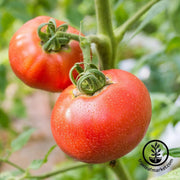Out Of Stock!
We will notify you when this product becomes available.
Tomato Seeds - Slicing - Ponderosa Red
80 Days to maturity (from transplant). Solanum lycopersicum. Ponderosa Red Tomato Seeds. Non-GMO, warm season annual, open-pollinated, heirloom, indeterminate, slicing tomato. Suitable for growing in garden plots, raised beds, greenhouses. A beefsteak slicing tomato that produces great yields of 8-16 oz fruits with a low seed count and mildly sweet flavor. ~7,500 seeds/oz.




Download Free Vegetable Growing Guide PDF
Growing Ponderosa Red Tomatoes in the Vegetable Garden
Use a well-draining seed starting mix composed of organic potting soil, coconut coir, and perlite, planting the seeds about a quarter inch deep in individual containers. Provide adequate light, either from natural sunlight or a grow light, and maintain consistent moisture to facilitate germination. Once the seedlings develop true leaves and reach a height of 6-8 inches, it's time to transplant them. Choose a sunny garden location with well-draining soil enriched with compost for optimal fertility. Before transplanting, it's crucial to harden off the seedlings gradually. Introduce them to outdoor conditions by placing them outside for a few hours each day, gradually increasing the duration over a week. This acclimatization process prepares the seedlings for the transition to the garden, reducing the risk of transplant shock.
When transplanting Ponderosa Red tomato seedlings, ensure proper spacing to allow for optimal growth. Dig a hole deep enough to accommodate the root ball and bury the stem, including the lower set of leaves. This promotes maximum root development and establishment. Water the transplants thoroughly and consider adding a handful of well-aged compost or worm castings to the planting hole to provide essential nutrients. Watering practices are crucial for healthy Ponderosa Red tomatoes. Water consistently, keeping the soil evenly moist but not waterlogged. Utilize a soaker hose or drip irrigation system to water at the base of the plants, minimizing the risk of fungal diseases. Mulching around the plants with organic materials like straw or shredded leaves helps retain moisture, suppress weeds, and regulate soil temperature.
Pruning is an essential practice to promote airflow and focus the plant's energy on fruit production. Remove suckers that develop in the leaf axils, allowing the main stem to channel nutrients to developing tomatoes. Provide support for the plants with stakes or cages to prevent sprawling and ensure proper ventilation.Consider applying a balanced organic fertilizer during the growing season to encourage maximum root development and overall plant health. Worm castings, rich in nutrients and beneficial microorganisms, can be incorporated into the soil or used as a top dressing around established plants.
Harvesting Ponderosa Red Tomatoes
Harvesting tomatoes at the peak of ripeness ensures optimal flavor and texture. Pick tomatoes with a vibrant color, firm texture, and a slight give when gently squeezed. Use sharp scissors or pruning shears to avoid damaging the plant. After harvesting, store tomatoes at room temperature to allow them to ripen fully. However, refrigeration can slow the ripening process and extend freshness if tomatoes are already ripe and won’t be immediately consumed.
To preserve a surplus of tomatoes, consider canning, freezing, or sun-drying. Canning involves processing tomatoes in jars with acidic ingredients while freezing requires blanching and freezing whole or chopped tomatoes. Sun-drying involves dehydrating tomatoes in sunlight or using a dehydrator to create flavorful dried tomatoes for various culinary uses./p>
About Ponderosa Red Tomato Garden Seeds
The Ponderosa Red tomato likely got its name due to its large size and distinctive Red color. "Ponderosa" often conveys a sense of grandeur and size, reflecting the tomato's substantial dimensions. The addition of "Red" in the name specifies the unique coloration of the fruit, indicating its characteristic scarlet red hue when ripe. Naming conventions for tomatoes often consider attributes such as size, color, or flavor, providing a descriptive and evocative name for gardeners and consumers.
Consuming tomatoes daily offers numerous health benefits. Rich in vitamins, especially vitamin C, tomatoes support immune function and skin health. Their high antioxidant content, including lycopene, may reduce the risk of chronic diseases. Additionally, tomatoes provide hydration, promote heart health, and contribute to overall well-being with nutrient density.
>The tomatoes are low acid and low seed count and are great for salads, sandwiches, etc. Mildly sweet flavor with a meaty consistency. It is a very popular tomato for home gardens and market growers. These tomatoes are renowned for their large size, typically weighing up to two pounds, making them a substantial and visually impressive addition to the garden. Ponderosa Red tomatoes also boast a rich, classic flavor, making them ideal for various culinary uses.
Ponderosa Red is an indeterminate variety. Unlike determinate varieties with a set growth period, indeterminate tomatoes continue to grow and produce fruit throughout the season. Indeterminates plants benefit from staking or caging to support their ongoing growth. Pruning is also common to manage their vigorous vines, ensuring adequate airflow and focusing energy on fruit development.
Their disease resistance and adaptability to different climates make them a reliable choice for home gardeners. The combination of size, flavor, and reliability makes Ponderosa Red tomatoes a popular and rewarding option for those seeking a robust and flavorful tomato variety.
Tips From Our Gardeners
"One of my favorite resources for details on tomato growing is the True Leaf Market Vegetable growing guide. You can download a digital copy for free or purchase a hard copy."
 |
- Lara Wadsworth, True Leaf Market Writer |
Other Resources
Ponderosa Red Tomato Seeds Per Package:
- 250 mg - Approximately 66 Seeds
- 1/4 oz - Approximately 1,875 Seeds
- 1 oz - Approximately 7,500 Seeds
- 4 oz - Approximately 30,000 Seeds
- 1 lb - Approximately 120,000 Seeds
Non-GMO Ponderosa Red Tomato seeds are available for Fast Free Shipping on qualifying orders.
Basic Info
| Latin Name: | Solanum lycoperscium (previously Lycopersicon esculentum) |
| Tomato Type: | Slicing - Larger, round tomatoes, the size of your fist or larger. |
| Ponderosa Red Tomato Color: | Red |
| Ponderosa Red Tomato Flavor: | Mildly sweet, low acid, meaty consistency. |
Growing Info
| Hardiness Zone: | 2, 3, 4, 5, 6, 7, 8, 9, 10, 11 Annual: Not intended to overwinter |
| Days to Maturity: | 80 (from transplant) |
| Days to Germination: | 7-10 |
| Seeding Depth: | 0.25 inch |
| Plant Spacing: | 24-36 inches |
| Row Spacing: | 36 inches |
| Plant Height: | 36-96 inches |
| Growth Habit: | Indeterminate - Indeterminate tomatoes are vine-type plants that sprawl (requiring a cage or trellis to support them) and continue to grow throughout the season. Indeterminate tomato plants will continue to produce tomatoes for the rest of the season, so you can harvest continually. |
| Soil Preference: | Well-draining, loose (sandy loam), slightly acidic (6.2 to 6.8), and moisture retaining. Too much nitrogen in the soil may lead to more foliage production and less fruiting. Tomatoes like more phosphorus and potassium than other vegetables. |
| Temperature Preference: | Warmer (70-85 F) |
| Light Preference: | Full Sun |
Other
| Direct Sow: | No |
| Start Indoors: | Yes. Start Indoors 7-9 weeks before your last spring frost date. |
| Plant Width: | 24 inches |
| Plant Spread: | 24 inches |
| Growth Speed: | Mid - Ready to harvest 70 to 80 days from transplant. Tricky to get a tomato by the 4th of July with these varieties. They are good mid-summer producers for most USDA Zones. |
| Germination Temperature: | 65-85 F |
| Pests and Diseases: | Common pests known to harm tomato plants, in general, include the tomato hornworm, cutworm, aphids, flea beetles, tomato fruit worms, and whiteflies. Also, watch for common diseases such as blossom end rot, fusarium wilt, powdery mildew, verticillium wilt, late blight, bacterial canker/spot, and tobacco mosaic virus. Most of these can be prevented by maintaining a regular watering schedule and avoiding overwatering. Regularly check your plants for pest damage throughout the season. For treating pest and disease problems, we recommend using an organic neem-based product. |
| Garden Size: | Greenhouse, Garden Plot, Raised Bed |
| Tomato Use: | Salads, fresh eating, slicing |














